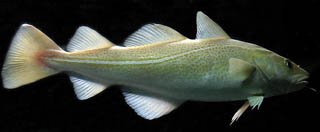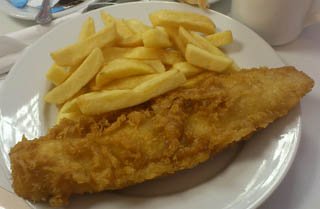Atlantic Cod Nutrition facts
Atlantic cod are large, white-fleshed fish that inhabit oceanic, colder waters along the Northern Atlantic coasts. Belonging to the Cod (Gadidae) family, Atlantic cod are benthic (groundfish) species found in deep offshore waters, typically at depths less than 500 meters.
Scientific name: Gadus morhua. Genus: Gadus. This species is recognized by various local names, including cod in English, torsk in Danish, morue franche in French, ogac in Inuktitut (Nunavut), and Bacalhau in Portuguese.
 |
| Atlantic cod (Gadus morhua). Photo: Per Harald Olsen |
Atlantic cod, a member of the cod family that also includes Pacific cod, Greenland cod, and Alaska pollock, is a deep-sea, bottom-dwelling fish.
Morphologically, what sets cod apart from most other Gadus genus members is the presence of three dorsal fins and two anal fins on their bodies. In other respects, they share characteristics with their cod relatives, featuring streamlined, fusiform-shaped bodies and a distinct white lateral line extending from the gill slit above the pectoral fin to the base of the tail fin.
Habitat: Atlantic cod are benthic (demersal) fish that inhabit the ocean floor close to gravel and cobble substrates in deep waters, typically at depths ranging from 200 to 500 meters. They do not undertake extensive long-distance migrations.
These cod are known for their ability to change their coloration to blend in with their surroundings. Their diet consists of a variety of bottom-dwelling creatures, including mollusks, worms, crustaceans, sea stars, fish eggs, as well as small fish like sardines, anchovy, and herring.
Biology: Atlantic cod are classified as batch spawners. Upon reaching maturity, they typically attain a length of around 3 feet and weigh between 15 to 30 pounds. These fish have a lifespan of approximately 25 years, although the typical catch ranges from 5 to 15 years in age.
Health benefits of Atlantic cod
Atlantic cod is one of the finest sources of essential fatty acids, protein, minerals, and fat-soluble vitamins like vitamin A, E, and D.
It is non-oily, deep water fish, and therefore, low in calories and saturated fats; 100 g holds just 82 calories in comparison to 91 calories in halibut.
It composes lean, flaky white meat that composes a good amino-acids profile. 100g fish provides 17.81 g/100 g (32% of RDI). Protein composition is complete in the sense that all essential amino acids in a healthy proportion.
Science-backed studies suggest that eating seafood can help decrease the risk of heart attack, stroke, obesity, and hypertension. Seafood is low in saturated fat and higher in “heart-healthy” polyunsaturated fat, including omega-3 fatty acids.
Cod liver oil is a dietary supplement derived from the liver of codfish (Gadidae). It contains the omega-3 fatty acids eicosapentaenoic acid (EPA), docosapentaenoic acid (DPA), and docosahexaenoic acid (DHA).
Research studies suggest that omega 3's, particularly DHA, play an important role in the development of the nervous system, especially in infants and children.
Cod liver oil also contains vitamin-A and vitamin-D. It is given to children to prevent rickets and dry eyes conditions that result from the deficiencies of vitamin-D, and vitamin-A respectively.
According to Cornell University and the New York Sea Grant Extension Program. 2012- the fatty acids play crucial role in decreasing blood pressure and heart rate and help improve cardiovascular function. For example, research has shown that omega-3 fatty acids decrease the risk of arrhythmias (abnormal heartbeats) that can lead to sudden death.
In adults, several large trials have evaluated the effect of fish or fish oils on heart disease. In the "GISSI Prevention Trial, heart attack survivors who took a 1-gram capsule of omega-3 fats every day for three years were less likely to have a repeat heart attack, stroke, or die of sudden death than those who took a placebo".
Being a deep-water fish, cod contains little vitamin-A in its flesh. Nonetheless, its liver carries ample amounts of omega-3's such as ALA, DHA, and DPA to help keep hair, mucosa, and skin healthy.
Atlantic cod fillet composes B-complex vitamins such as niacin, pyridoxine (B-6). It is also a good source of vitamin-E, vitamin-B12, thiamin, and riboflavin.
Its flesh contains just 0.111 ppm of mercury in its flesh. US FDA categorizes atlantic cod in the "best choice" section considering mercury levels in its flesh. The recommended consumption is 2-3 serving (8-12 ounces) per week for cod.
Further, it is a natural source of rich minerals including iodine, calcium, zinc, potassium, phosphorus, and magnesium. Iodine is an important trace element in human nutrition and is essential for thyroid hormone synthesis.
| Principle | Nutrient Value | Percent of RDA |
|---|---|---|
| Energy | 82 Kcal | 4% |
| Carbohydrates | 0 g | 0% |
| Protein | 17.81 g | 31.8% |
| Total Fat | 0.67 g | 3.4% |
| Cholesterol | 43 mg | 14% |
| Dietary Fiber | 0 g | 0% |
| Vitamins | ||
| Folate total | 7 μg | 1.75% |
| Niacin | 2.063 mg | 13% |
| Pyridoxine | 0.245 mg | 19% |
| Riboflavin | 0.065 mg | 5% |
| Thiamin | 0.076 mg | 6.3% |
| Vitamin-A | 40 IU | 1.3% |
| Vitamin-C | 1 mg | 1.5% | Electrolytes |
| Sodium | 54 mg | 3.7% |
| Potassium | 413 mg | 8.8% |
| Minerals | ||
| Calcium | 16 mg | 1.6% |
| Iron | 0.38 mg | 5% |
| Magnesium | 32 mg | 8% |
| Phosphorus | 203 mg | 29% |
| Selenium | 33.1 mg | 60% |
| Zinc | 0.45 mg | 4% |
Buying
Atlantic cod can be found in various forms, including canned, air-dried (known as "stockfish"), or salt-cured (referred to as "kipper"). Codfish roe can be enjoyed fresh, smoked, or salted, and other parts such as the tongue, cheek, and liver are also edible.
These Atlantic cod products are available year-round. However, the freshest cod is typically found from June to October when they have fully recovered from spawning. During this time, the fish are plump, and their flesh is sweet and firm.
If you are in search of fresh cod, look for bright, firm fish with clean skin, pink gills, and clear eyes. Fillets may be sold with or without skin, but it's advisable to avoid soft fillets as they have a tendency to disintegrate during cooking.When storing cod at home, keep it in the refrigerator for 2-3 days. For longer storage, it's recommended to scale and gut the whole fish before placing it in the deep freezer at temperatures below -30°C.
Preparation
To prepare dried, salted cod, begin by soaking it in cold water before cooking. To remove the excess salt, place the cod in a strainer with the skin side up (if it has skin) to prevent salt from accumulating between the flesh and skin. Submerge the strainer in a large container filled with water, allowing the salt to collect at the bottom.
Atlantic cod is a sweet-flavored fish known for its ability to absorb the flavors of the surrounding ingredients in a dish. Its non-oily, flaky, white flesh is reminiscent of other cod varieties such as hake, haddock, and Alaska pollock, making it a popular choice for recipes that call for white fish.
Atlantic cod is exceptionally versatile when it comes to cooking. You can prepare it through various methods such as grilling, baking, steaming, pan-searing, broiling, poaching, or sautéing to savor its delicious flavor.
Here are some serving ideas:
 |
| Fish n Chips. Photo credit: david pursehouse |
Create a delightful 'Fish n Chips' dish by frying it in a light batter.
For a tasty twist, use smoked Atlantic cod in fish lasagna or pie, especially when combined with an equal amount of fresh white fish like hake.
Bacalhau is the Portuguese term for dried and salted cod. Bacalhau à Gomes de Sá is a casserole originating from Northern Portugal and prepared with dried salted cod, potatoes, eggs, olives, and onion, making it a regional specialty.
Safety profile
The methyl-mercury content of fresh/frozen Atlantic cod is 0.111 parts per million (PPM).
This categorizes Atlantic cod as a "Best Choice" fish, indicating lower levels of mercury compared to other fish varieties.
The FDA advises that individuals can eat 2 to 3 servings a week from the "Best Choice" list. For adults, one serving typically equals 4 ounces of fish.
Also read ≺≺-
≺≺- Mercury in Fish: Health Benefits, Risks, and Safe Choices
≻≻-Salmon nutrition facts and health benefits.
≻≻- Trout fish nutrition facts and health benefits.
≻≻- Dover sole nutrition facts and health benefits.
≻≻- Back to Seafood from Atlantic cod nutrition facts and health advantages.
Further reading (Links opens in new window):
Species Fact Sheets -Gadus morhua.
Omega-3 Fatty Acids: An Essential Contribution.